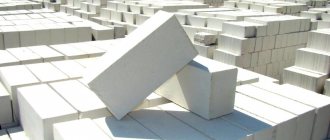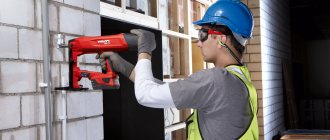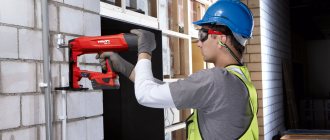A concrete mounting gun is a special tool designed for fastening various structures, parts and elements to monolithic concrete surfaces. The device offers a fairly broad functionality, different types of action, and can work not only with concrete, but also reinforced concrete (even with high-density reinforcement), cinder block, brick, etc.
Thanks to the use of a mounting gun, you can significantly reduce the time and effort required to complete the task, especially when it comes to impressive volumes of work.
The construction gun for concrete allows you to quickly and reliably fasten various equipment (ventilation, plumbing, electrical, etc.), hydro/sound/heat insulating, wall and finishing, roofing materials using dowel-nails.
A dowel gun for concrete makes it possible to significantly increase installation productivity and does not require pre-drilling of fasteners. Typically, pistols are produced quite massive (up to 5 kilograms) in order to increase the efficiency of the process. According to the principle of operation, a concrete gun can be gas, pneumatic, powder, electric, etc.
You can use the tool in the most inaccessible places; you should choose it in accordance with the volume of intended work, operating conditions, requirements and current characteristics.
Device characteristics
Depending on the model, the properties and performance of construction guns for dowels may vary, but they also have parameters common to all:
- manual or semi-automatic method of feeding the cartridge;
- weight of a loaded pistol - 3.1−5 kg;
- electric, powder, battery or gas powered;
- single-charge or multi-charge device for supplying elements for fixation;
- device length - 345−475 mm;
- trunk diameter - 8.2−12.5 mm;
- operating temperature range - from -31 to +53 ° C.
Choosing a compressor for a nailer
To operate, a pneumatic nailer requires a compressor, and this device must be purchased separately. When purchasing a nail gun, it is recommended that you carefully study its instructions and find out if the tool has specific requirements for the air blower.
It is better to choose a compact compressor for a nailer so as not to weigh down the structure.
Most often, nailers work with compressors up to 8 bar. Such units provide sufficient performance, but at the same time they cost quite moderately and do not look very bulky.
Areas of use
Nailers are used in construction for driving dowels, studs, nails and pins into various types of surfaces. It is mainly used for working with surfaces based on:
- plastic;
- concrete;
- natural and artificial stone;
- wood;
- ceramic and silicate bricks.
This tool is suitable for voluminous work involving repeated repetition of monotonous actions.
The dowel gun is used for the following purposes:
- Laying communications in the interior of the building. The speed of driving in elements for fasteners directly affects the quality of installation. If the clamps are installed slowly, they may become skewed. This will lead to a decrease in the functioning of Internet cables, antenna wires and the electrical network during their operation. Quick fastening of dowels using a nailer guarantees precise and even fixation of the elements. To achieve the optimal result, it is necessary to carry out the markings and calculations correctly.
- Siding covering the facade of a building. Decorative finishing involves fastening a large number of elements to the walls with nails.
- Installation of soft roofing. This process requires uniform and high-quality fastening of all elements, which is quite difficult to do manually. The adjustment system in the mounting gun allows for optimized work.
Top 10 best nailers for frame houses
In frame construction, nail guns are used for long fasteners of 50 mm or more. There are many corresponding models on the market, mainly pneumatic and gas devices.
Toua GFN3490 CH Li
The gun for long slatted nails operates using a battery, and the impact energy is provided by flammable liquefied gas. The nailer is designed for working with wood, plywood and fiberboards and demonstrates good resistance to negative temperatures. On one battery charge it can fill up to 4000 elements.
The average price of a Toua nail gun is 28,000 rubles
Fubag N70C
The pneumatic nailer for 45-70 mm nails is suitable for framing work. It has a drum-type magazine for 300 fasteners and is capable of operating at an inclination of 15 degrees. The hammering force can be adjusted; the nailer operates by contact.
You can buy Fubag N70C from 14,000 rubles
DeWalt DCN890N
The rapid-fire cordless gun with a brushless motor works with nails of an average length of 57 mm. Produces 240 strikes per minute, the magazine holds only 33 fasteners. The triggering power can be adjusted, and there is illumination for the work area.
You can buy a nailer DCN890N from 39,000 rubles
AEG B18N18-0
The wear-resistant pistol supports single and rapid-fire modes, works with elements up to 55 mm in length. Designed exclusively for driving nails into wood. There is LED lighting and convenient access to the store; the kit includes a storage case.
You can buy an AEG nail gun from 28,000 rubles
DeWalt DCN660N
The medium-power cordless nailer is capable of driving 32-63 mm fasteners into wood. It has a good magazine with 110 elements and adjustable impact force; it can perform 240 strikes per minute.
You can buy a nailer DCN660N from 31,000 rubles
Fox Weld Aero 6522
The pneumatic contact nailer for 40-90mm nails holds 300 fasteners in a drum magazine and can operate at a 15 degree angle. It operates with an 8 bar compressor and can drive elements both completely and with incomplete immersion into the wood.
You can buy a frame pistol Fox Weld Aero from 24,000 rubles
Fubag N65C
Another model from a popular brand works on a pneumatic principle with a 7 bar compressor. The maximum length of fasteners is 55 mm. In this case, 400 elements are placed in the drum. The gun shows very good performance, although its use in frame construction is limited due to the average length of the nail.
You can buy a Fubag nailer from 13,000 rubles
AF-0034
Powerful nailer for 100 mm slatted nails works with smooth, rough, galvanized types of fasteners. Suitable for driving elements at an angle, balanced to be held in one hand. The nose of the device is equipped with spikes that prevent the nozzle from slipping off an inclined or wet surface.
You can buy a nailing tool AF-0034 from 26,000 rubles
Caliber PGSZ-18
The pneumatic nailer is designed to work with 50 mm fasteners. It copes well with repair and construction tasks, fires almost no blank shots and rarely bites nails and staples. It has a budget price and at the same time shows good quality of impacts. The only downside is the lack of additional options and settings, but for the price the nailer is very good.
The average cost of a Caliber nail gun is only about 2,400 rubles
Hitachi NT 65A2
The rapid-fire air gun fires 180 times in a minute and holds 150 nails in its magazine. The length of the fastening element is a maximum of 65 mm.
The cost of a Hitachi NT nail gun is about 12,000 rubles
Popular models
The GFT-307 powder piston gun is used with 5.6x16 mm cartridges and can drive dowels up to 76 mm long and 8 mm in diameter. Replacing the piston is required after 1500 shots, cleaning the device after 1000. The weight of the device is 1.85 kg. When the chamber is opened, a semi-automatic ejection of the spent cartridge occurs. There is blocking from an unplanned shot. The screen (stop) provides protection from flying particles of material and ricochet. Model price 6500 rub.
The Spit P370 multi-charge mounting device is suitable for all types of mounting. It has low recoil, a good rate of fire, and the ability to adjust the shot energy. There is a large selection of materials to use. The weight of the device with the magazine is 3.2 kg, without it - 2.8 kg. The pressing force for the shot is 17 kg. Suitable for working with steel and concrete. Can hammer up to 700 nails per hour. Price - 46,700 rub.
Gas mounting gun for dowels - disadvantages
And yet, a gas nailer cannot be called ideal. Craftsmen working with it will also have to put up with some disadvantages. The first thing that catches your eye is the presence of exhaust gases, which you should not breathe at all, so the room in which the work is carried out must be well ventilated. The combustion chamber periodically needs to be cleaned of carbon deposits and soot.
Compared to an air pistol, models powered by gas are still larger in size, and the price of a shot is more expensive. The cost of a gas installation nail gun can be several times higher than analogues with another drive. However, this price is justified by its versatility, because it’s not for nothing that gas and powder devices are classified as professional.
Features of operation
Dowel-nails used in construction guns differ from conventional fasteners in their special configuration and structure. They are a nail with a washer located at the tip, which ensures a tight connection between the fastener and the surface.
To obtain a high-quality result, you need to understand how to use a construction gun correctly. The tool is used as follows:
- the place where the dowel will be located is preliminarily outlined;
- the charged device is brought close to the surface and a shot is fired;
- the rod goes deep into the material, the washer moves and fixes at the nail head.
Dowels with porous surfaces cannot be used. The fastener may fall into the material or not securely fasten.
Originally posted 2018-04-06 09:24:27.
Gas nail gun – advantages
The gas-powered unit has a number of significant advantages over other models powered by pneumatic, powder or electric drives. Obvious advantages are the complete autonomy of the unit from external energy sources. In this regard, only cordless nailers can “compete” with gas models, but they are not enough for such a large number of shots, and the shot force is only sufficient for small fasteners and soft substrates, such as wood, plastic and drywall. The ergonomics of a gas nailer also benefits because it is not tied to an energy source by any hoses or wires, like a pneumatic gun or electric models. This is why roofers prefer gas-powered tools.











